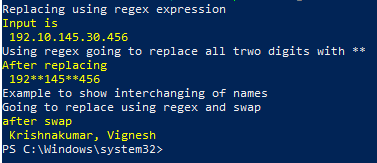

Note that if you use -match in an if statement, you should not pipe to Out-Null, as demonstrated below. The result of -match will normally either be True or False, but this is suppressed here by piping to Out-Null. Read more about regexp character classes here. Below you will see that "abc" is now included in $Matches, because I added "+", which means "match one or more characters from a to z, inclusively, match as many as you can". If you have "surrounding" regexp parts around the captured part, they will be included in $Matches which holds the complete regexp match. NET uses the Unicode definition of a "word character", so it includes, among other things, accented and Scandinavian alphabet characters. The built-in classes like \d and \w can respect locale. Rather than "\d", you could also have used the character class "" - I am not aware of a locale with "other digits" included in "\d". This will extract the first occurrence of digits (0-9) in sequence in a string. So $Matches contains the content of the first capture group, $Matches the content of the second capture group, and so forth. The first element, indexed by $Matches, contains the complete match (which will be the same in this case), while $Matches contains the nth match, corresponding to $1, $2, $3 and so forth in Perl.

The captures, indicated by the parentheses in the regexp, are stored in the hashtable $Matches. Basically, I've found its syntax and behaviour to overlap with Perl's and Python's in most respects.Įverything in this article should work in PowerShell version 2 and up.Įxample - The -match OperatorThis first example uses the regular expression (\d+) and runs it against the string. This Python doc about regex seems like a good place to learn about basic regex syntax (which will work the same in. I have a Perl background myself, so I will make a few comparisons. There are quite a few resources on this on the web, but I will look into writing a generic tutorial that will cover some common cases and pitfalls.

I have realized a lot of people don't know regexp syntax/logic. I will assume you are familiar with both PowerShell and regular expressions and want to know how to use the latter in PowerShell. A regular expression is a sequence of logically combined characters and meta characters (characters with special meaning) that, according to parsing rules in the regexp engine, describes text which matches a certain pattern.


 0 kommentar(er)
0 kommentar(er)
